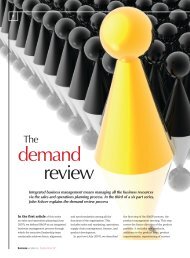Demand Planning Article: The Pitch and the Catch - Oliver Wight ...
Demand Planning Article: The Pitch and the Catch - Oliver Wight ...
Demand Planning Article: The Pitch and the Catch - Oliver Wight ...
You also want an ePaper? Increase the reach of your titles
YUMPU automatically turns print PDFs into web optimized ePapers that Google loves.
cat<br />
<strong>The</strong><br />
pi<br />
an<br />
8 www.bus-ex.com SEPTEMBER 09
Strategic management<br />
<strong>Dem<strong>and</strong></strong> planning 4<br />
tch<br />
d<br />
<strong>the</strong><br />
ch<br />
<strong>The</strong> final article in this four-part<br />
series explains how integration<br />
<strong>and</strong> alignment combine to make<br />
dem<strong>and</strong> planning your lifeline in<br />
<strong>the</strong> recession<br />
By Susan Storch, Principal,<br />
<strong>Oliver</strong> <strong>Wight</strong> Americas<br />
<strong>Dem<strong>and</strong></strong> planning, often underutilized in<br />
<strong>the</strong> best of times as a means of improving<br />
cash flow <strong>and</strong> profitability, may become<br />
your company’s lifeline in a recession.<br />
This four-part series discusses dem<strong>and</strong><br />
planning best practices in relation to<br />
surviving, <strong>and</strong> even thriving, in <strong>the</strong> downturn <strong>and</strong> emerging<br />
in <strong>the</strong> best possible financial health.<br />
Part 1 explored <strong>the</strong> high benefit potential in cash <strong>and</strong><br />
profit of dem<strong>and</strong> planning <strong>and</strong> laid out <strong>the</strong> three fundamental<br />
moves you have to take to achieve it. Part 2 explained<br />
<strong>the</strong> first move, quickly designing best practices into your<br />
dem<strong>and</strong> planning process. Part 3 addressed <strong>the</strong> second<br />
move, equipping people to run at best practice process<br />
capability. <strong>The</strong> final article in this series examines <strong>the</strong> third<br />
fundamental move, integration <strong>and</strong> alignment.<br />
If you have been following this series, you know that <strong>the</strong><br />
dem<strong>and</strong> planning lifeline has been thrown, a strong line<br />
snaking out, guided by capable h<strong>and</strong>s. <strong>The</strong>re was <strong>the</strong> pitch<br />
<strong>and</strong> now <strong>the</strong>re has to be <strong>the</strong> catch.<br />
Winning with dem<strong>and</strong> planning<br />
Remember that <strong>the</strong> dem<strong>and</strong> plan we have been talking<br />
about contains <strong>the</strong> business’s revenue projections based<br />
on planned marketing <strong>and</strong> selling activities to achieve <strong>the</strong>m.<br />
Marketing <strong>and</strong> sales reached consensus on a plan, <strong>and</strong><br />
now marketing <strong>and</strong> sales have to execute <strong>the</strong> plan — “<strong>the</strong><br />
pitch <strong>and</strong> <strong>the</strong> catch.” This is <strong>the</strong> third fundamental move:<br />
integrating <strong>and</strong> aligning <strong>the</strong> upgraded dem<strong>and</strong> planning<br />
process with o<strong>the</strong>r commercial execution processes <strong>and</strong><br />
also with product development, supply chain, <strong>and</strong> finance.<br />
Winning with dem<strong>and</strong> planning takes <strong>the</strong> engagement <strong>and</strong><br />
synchronization of <strong>the</strong> entire business in <strong>the</strong> catch.<br />
Given a portfolio of desirable products <strong>and</strong> services <strong>and</strong><br />
adequate financing, it is marketing that is <strong>the</strong> leading link<br />
in <strong>the</strong> chain of events that ends with a satisfied customer.<br />
<strong>The</strong> dem<strong>and</strong> plan sets <strong>the</strong> drive chain in motion. A tug on<br />
<strong>the</strong> chain <strong>and</strong> <strong>the</strong> rest of <strong>the</strong> linkage follows: money is spent<br />
<strong>and</strong> resources are consumed. This is not to downplay <strong>the</strong><br />
09 SEPTEMBER www.bus-ex.com 9
importance of any one function, but actually to emphasize<br />
<strong>the</strong> equal importance of all in <strong>the</strong> success—or failure—of<br />
customer delight, that sweet result that leads to more sales,<br />
more profitably delivered. Without follow-through, dem<strong>and</strong><br />
planning is a waste of time.<br />
Execution<br />
In customer-facing business<br />
organizations, dem<strong>and</strong> plan<br />
follow-through is spelled<br />
“execution.” In <strong>the</strong> altered<br />
dynamics of a recession,<br />
customer <strong>and</strong> consumer<br />
behaviors change in<br />
unexpected ways. <strong>The</strong> norm<br />
is no longer <strong>the</strong> norm, <strong>and</strong><br />
in executing <strong>the</strong> dem<strong>and</strong><br />
plan we discover where our<br />
assumptions were “off.”<br />
Explicitly defined actions<br />
to create or shape dem<strong>and</strong><br />
may need to be fine-tuned<br />
or drastically altered as <strong>the</strong><br />
reality of customer orders<br />
<strong>and</strong> consumer sales unfolds.<br />
Mining this mo<strong>the</strong>r lode of<br />
learning opportunity is often<br />
mistakenly left purely to<br />
<strong>the</strong> puny pickaxe of human<br />
memory. Unfortunately, people<br />
come <strong>and</strong> go with greater<br />
frequency than recessions,<br />
<strong>and</strong> often because of <strong>the</strong>m<br />
(especially <strong>the</strong> old guys with<br />
<strong>the</strong> longest memories <strong>and</strong><br />
biggest paychecks).<br />
Follow-through starts with<br />
timely execution of <strong>the</strong> dem<strong>and</strong><br />
plan. One company I was<br />
working with as <strong>the</strong> recession<br />
hit developed a dem<strong>and</strong><br />
plan that incorporated price<br />
increases to compensate for<br />
radically escalating commodity<br />
prices. Sales had participated<br />
in <strong>and</strong> committed to <strong>the</strong> consensus dem<strong>and</strong> plan, yet<br />
delayed in communicating increases to customers for fear<br />
<strong>the</strong>y would take <strong>the</strong>ir business elsewhere. Time told <strong>the</strong><br />
truth, that customers did not appreciably reduce orders,<br />
but meanwhile revenues were lost <strong>and</strong> margins went<br />
“under water.” Had <strong>the</strong> sales force been incented purely<br />
“Integrated business<br />
planning is <strong>the</strong> process<br />
being used by leading<br />
companies to ensure<br />
cross-functional process<br />
integration <strong>and</strong> full<br />
organizational engagement<br />
in coordinated planning<br />
<strong>and</strong> execution of dem<strong>and</strong>,<br />
supply, product, <strong>and</strong><br />
financial plans”<br />
in revenues instead of on both revenues <strong>and</strong> gross margin,<br />
<strong>the</strong> damage would have been far greater.<br />
Formally documented assumptions guide execution <strong>and</strong><br />
are managed to improve results in future plans. Earlier in<br />
this article series, I explained <strong>the</strong> importance of clearly<br />
documented (<strong>and</strong> communicated) assumptions upon<br />
which <strong>the</strong> dem<strong>and</strong> plan <strong>and</strong><br />
alternate scenarios of risk<br />
<strong>and</strong> opportunity are based<br />
<strong>and</strong> execution actions are<br />
formulated. Now, as reality<br />
unfolds, quick follow-up on<br />
assumptions is important to<br />
learn what is working (or not)<br />
<strong>and</strong> why <strong>and</strong> how to adjust<br />
course. In a recession, “quick”<br />
follow-up often means daily. It<br />
is <strong>the</strong> purview of <strong>the</strong> marketing<br />
<strong>and</strong> selling functions <strong>and</strong><br />
<strong>the</strong>ir analytical support arms,<br />
market intelligence <strong>and</strong><br />
dem<strong>and</strong> planning.<br />
As part of dem<strong>and</strong> plan<br />
follow-through, assumption<br />
effects should be tracked,<br />
analyzed, <strong>and</strong> revised<br />
by those responsible for<br />
executing <strong>the</strong> actions related<br />
to <strong>the</strong>m <strong>and</strong> accountable for<br />
<strong>the</strong>ir results. Thus, influences<br />
of trade spend on customer<br />
behavior need to be analyzed<br />
<strong>and</strong> interpreted by field<br />
sales or account managers.<br />
Marketing needs to analyze<br />
<strong>and</strong> record <strong>the</strong> actual impact<br />
of marketing activities.<br />
Consumer information,<br />
including competitive analysis,<br />
particularly in fast-moving<br />
consumer goods companies,<br />
comes from internal <strong>and</strong>/or<br />
external intelligence groups.<br />
All toge<strong>the</strong>r, a shared historical<br />
knowledge develops that informs <strong>the</strong> future. This is<br />
assumption management, a crucial outgrowth of execution<br />
<strong>and</strong> a powerful tool for improving assumption validity. I<br />
have worked with companies where its longevity spans<br />
multiple recessions. It is <strong>the</strong> perfect antidote for imperfect<br />
human memory.<br />
10 www.bus-ex.com SEPTEMBER 09
Strategic management<br />
<strong>Dem<strong>and</strong></strong> planning 4<br />
Measurement provides <strong>the</strong> pulse check on <strong>the</strong> dem<strong>and</strong><br />
plan. Keep your finger on <strong>the</strong> pulse at all times. Measure<br />
execution of specific marketing <strong>and</strong> sales activities, for<br />
<strong>the</strong>y lead <strong>the</strong> plan. Monitor orders versus plan compared<br />
to <strong>the</strong> expected pattern of orders throughout <strong>the</strong> period,<br />
typically a month (in this recession, many companies have<br />
moved to daily monitoring to give <strong>the</strong>mselves <strong>the</strong> most time<br />
to shape dem<strong>and</strong>). Assumption performance ought also to<br />
be measured <strong>and</strong> personal accountability established for<br />
<strong>the</strong> measurable results of those assumptions. All measures<br />
should include causal analysis <strong>and</strong> action taking with<br />
projected impact on future performance.<br />
Discipline is actually liberating. Marketers often confide<br />
in me <strong>the</strong>ir fear that establishing execution disciplines will<br />
stifle <strong>the</strong>ir creativity. In fact, what <strong>the</strong>se disciplines prevent<br />
are unilateral decisions that sub-optimize <strong>the</strong> business.<br />
For example, one client of mine habitually ignored<br />
execution checkpoints in product launches for “creative<br />
reasons,” only to achieve unprofitable results time after<br />
time. In ano<strong>the</strong>r, individual br<strong>and</strong> managers cut deals<br />
with production facilities, undermining carefully planned<br />
resource use that led to customer service issues <strong>and</strong><br />
decreased margins. Having pre-defined rules/guidelines,<br />
timelines, <strong>and</strong> decision-making authorities greatly increases<br />
<strong>the</strong> probability of successful dem<strong>and</strong> plan execution.<br />
Anchoring <strong>the</strong> catch<br />
Anchoring <strong>the</strong> catch in supply <strong>and</strong> product management<br />
takes integration <strong>and</strong> alignment of planning <strong>and</strong> execution.<br />
In <strong>the</strong> not-too-distant past, a volume forecast, often inflated<br />
“just in case,” was heaved over <strong>the</strong> wall by marketing <strong>and</strong><br />
sales to manufacturing, who <strong>the</strong>n became a convenient<br />
whipping boy for all customer service <strong>and</strong> inventory issues.<br />
It was politically useful to have a disjoint, but any executive<br />
who condones this behavior in today’s vastly changed<br />
climate is a dinosaur deserving of extinction. Commercial’s<br />
accountability for <strong>the</strong> dem<strong>and</strong> plan <strong>and</strong> <strong>the</strong>ir engagement<br />
in execution does not end where manufacturing begins.<br />
<strong>Dem<strong>and</strong></strong> planning follow-through in <strong>the</strong> supply-side<br />
organizations requires <strong>the</strong> active participation of marketing,<br />
sales, <strong>and</strong> <strong>the</strong>ir support functions with supply planning,<br />
production, <strong>and</strong> logistics to build trust, collaborate in<br />
defining customer service <strong>and</strong> inventory policies, respect<br />
each o<strong>the</strong>r’s capabilities, <strong>and</strong> devise performance measures<br />
that find <strong>and</strong> correct cause, not assign blame.<br />
Both dem<strong>and</strong> <strong>and</strong> supply need to be well integrated <strong>and</strong><br />
aligned with product management to eliminate <strong>the</strong> many<br />
“I didn’t know that!” exclamations that often accompany<br />
product development <strong>and</strong> launch activities, if tight linkage<br />
has not been established. Tight linkage requires clear <strong>and</strong><br />
formal lines of communication, checkpoints, <strong>and</strong> reviews.<br />
Each of <strong>the</strong> primary functional areas has its own pacing<br />
that dictates integration <strong>and</strong> alignment points with <strong>the</strong><br />
o<strong>the</strong>rs. <strong>The</strong> need for speed <strong>and</strong> flexibility increases with<br />
<strong>the</strong> uncertainties of <strong>the</strong> recession <strong>and</strong> may warrant more<br />
frequent calibration.<br />
<strong>The</strong> insurance policy: Integrated business planning. How<br />
can marketing <strong>and</strong> sales leadership be sure that <strong>the</strong> dem<strong>and</strong><br />
planning pitch is caught <strong>and</strong> <strong>the</strong> lifeline holds Integrated<br />
business planning is <strong>the</strong> process being used by leading<br />
companies to ensure cross-functional process integration<br />
<strong>and</strong> full organizational engagement in coordinated<br />
planning <strong>and</strong> execution of dem<strong>and</strong>, supply, product, <strong>and</strong><br />
financial plans. Integrated business planning summarizes<br />
on a monthly basis <strong>the</strong> business performance, issues,<br />
<strong>and</strong> actions to navigate through rough recession waters,<br />
meeting changing customer/consumer dem<strong>and</strong>s in <strong>the</strong><br />
most profitable, cash-rich way. A mainstay of <strong>the</strong> process<br />
is business modeling to have ready contingency scenarios<br />
to call immediately into play as conditions change.<br />
Summary<br />
Why does it seem that we just flog away at execution,<br />
getting surprised over <strong>and</strong> over, making poor choices even<br />
knowingly sometimes, <strong>and</strong> coming up a day late or a dollar<br />
short on resources to execute at <strong>the</strong> right time, in <strong>the</strong> right<br />
place <strong>The</strong> issues that plague integration <strong>and</strong> alignment<br />
are again human: failure to communicate, lack of formal<br />
policies <strong>and</strong> procedures, unclear roles <strong>and</strong> responsibilities,<br />
lack of accountability for follow-through, inattentiveness to<br />
<strong>the</strong> underlying causes of poor performance, organizational<br />
politics, refusal to tell or hear <strong>the</strong> truth, closed minds.<br />
Common sense<br />
I hope you found this entire series to be nothing but<br />
common sense, because if you did, I know you are<br />
mentally ready to put dem<strong>and</strong> planning high on your list of<br />
recessionary opportunities. Get positioned to use dem<strong>and</strong><br />
planning to find <strong>and</strong> set course on <strong>the</strong> new money trail.<br />
<strong>The</strong> formula is simple: best practice processes, run by<br />
competently skilled <strong>and</strong> knowledgeable business people,<br />
with adequate resourcing <strong>and</strong> tools provided by executives<br />
who own <strong>and</strong> lead <strong>the</strong> change <strong>and</strong> dem<strong>and</strong> integrated <strong>and</strong><br />
aligned execution. Just do it!<br />
Susan L. Storch is a principal with <strong>Oliver</strong> <strong>Wight</strong> Americas.<br />
She is recognized as a leading expert in dem<strong>and</strong><br />
planning <strong>and</strong> change management, <strong>the</strong> two going very<br />
much h<strong>and</strong> in h<strong>and</strong>. Susan’s experience spans thirteen<br />
years with <strong>Oliver</strong> <strong>Wight</strong> <strong>and</strong> twenty years of executive<br />
management positions in industrial, CPG, <strong>and</strong> service<br />
sectors. Susan has led <strong>and</strong> coached many businesses<br />
to Class A business excellence certification.<br />
09 SEPTEMBER www.bus-ex.com 11
















